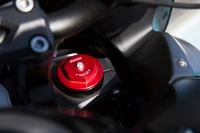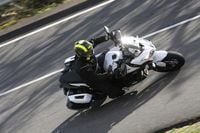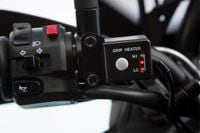It’s no secret that we like the Kawasaki Versys. We gave it Motorcycle of the Year in 2008, praised it again after the light restyling in 2010, and continue to find reasons for having one in our fleet. It gets better. For 2015, Kawasaki’s comprehensive revisit of the Versys has improved an already very good, very capable machine.
More to the point, it is now not only capable but good looking. Did we just call the old one ugly? As someone who has owned one, I can step up and say yes to that. I always loved its efficiency, the way it carved up tight canyon roads, and how well it could tour, but I never came to love its stacked-headlight face.
In search of a less polarizing appearance, Kawasaki’s stylists lifted a few licks from the popular Ninja line, specifically the Ninja 300, whose headlights peer out from the 650’s new, sharply creased face. With the rework, the fairing gets wider and taller, and mounts a windscreen that’s not only twice as large as the old one but it can be adjusted vertically by 2.4 inches via handy knobs. You can’t quite make changes from the saddle, but quick adjustments are easy when you’re stopped. Still more important are the results: The new fairing and windscreen combination have none of the bothersome turbulence of the old; true for me at 5-foot-9 and true for the other journalists at the launch in Catania, Sicily, scaling up to 6-foot-5. I preferred the screen in the lowest position, but suffered no turbulence for the extra coverage provided in the highest setting. Win, win.
Beneath the new bodywork, which includes a larger 5.5-gallon fuel tank (up by half a gallon) and a new tail section designed to carry Kawasaki's branded quick-release hard luggage, is a substantially updated motorcycle. To boost power, the 649cc parallel-twin engine enjoys updated ECU programming to work with a completely new, one-piece exhaust system. Kawasaki says that peak power is up by 5 hp, which should give it 63 or so at the rear wheel, or comparable to a V-Strom 650 .
Having put more than 10,000 miles on a 2012 Versys 650, I can say for sure that the engine feels a bit stouter, though some of that thrust is consumed by the bike’s weight increase. The LT model weighs 476 pounds wet, about 20 more than a base ABS version. The last Versys we had on the scales weighed 457 pounds with a full fuel tank (of half a gallon less capacity). As before, the engine is torquey and flexible, and carries relatively little top-end surge. In fact, the redline is reduced by 500 rpm this year, partly because owner feedback told Kawasaki that few Versys riders ever rung its neck. If anything, the 2015 engine feels freer and shifts better, though Kawasaki does not indicate any internal changes. From 2,500 rpm to about 8,500, the little engine thrums contentedly and pulls the Versys forward in a totally credible way. It won’t dislocate your shoulders, ever, but you rarely feel like you’re sitting around waiting for the power to arrive.
This year, the little twin is smoother too. Actually, it isn’t, but you feel like it is thanks to new rubber engine mounts. Before, only the upper rear engine mount was rubber, and the forward mount was rigid. (This mount encompasses two ears on the frame and two on the engine with a long through bolt; technically, these could be separate mounts, one supposes.) Now the forward mounts have rubber bushings, which makes for four total in the new setup; two that you can see under the radiator shrouds and two behind the engine that you can't. Where the old Versys’ tank would shimmer with vibration pretty much all the time, the new one is dead smooth. You don’t feel the same amount of tingle in the foot pegs or through the seat, either, and definitely not through the new rubber-mounted handlebar. In part of its briefing, Kawasaki admitted that the Versys had moved a bit away from the low-end/commuter end of the aspiration scale and over toward sport/touring, so more, smoother power was a necessity.
Chassis changes follow the idea of general updates that won’t break the bank. New suspension, from Showa, includes a shock with a remote hydraulic preload adjuster, a higher-rate spring, and new damping settings to go along with it. Kawasaki recognized that the standard saddlebags on the LT, plus the option of running a top box, would tax the old suspension. To further cope with the added weight, the rear subframe is beefed up.
Back to the suspension: The fork is a Separate Function design from Showa, with a single spring in the left leg and a preload adjuster; on the right side is the cartridge damping system with adjustable rebound via a screw at the top. As before, compression damping is not adjustable. In addition, the shock lost its rebound adjustment.
The final piece of the puzzle comes via Nissin, Finally…finally…Kawasaki has retired the old two-piston Tokico calipers and given the Versys fairly modern brakes. The compact, two-piston, sliding-pin calipers from Nissin benefit from different pad compounds than the Tokicos used, plus a different master cylinder. Both brakes are a huge improvement, with dramatically better initial bite and a more progressive lever feel. Petal-style rotors up front remain 300mm but the rear is a larger, 250mm item. Effective, if conservatively programmed ABS is standard.
With all these changes behind it, is the Versys 650 still the Versys we have come to love? Yes, absolutely. In fact, it’s better than ever, keeping a sense of balance and lightness (despite it not actually being that light) that gives you confidence on unfamiliar roads and over sketchy blacktop. To say the steering is telepathic is probably overstating, but not by a lot. Pull a bit on the comfortably positioned steel bar and the 650 heels right over, staying totally neutral to fairly prodigious lean angles. Turn in on the brakes? No problem. Hold a line on full-power corner exits? Yes, of course. There are few bikes that give you such a clear sense of what the wheels are doing and what the machine will do next. It’s comfortable, predictable, fun to flog, yet happy to churn along at 80 mph on the highway.
Suspension changes suggest different manners, but that’s not totally so. As before, the fork is softly sprung, which is only exacerbated by the stiffer rear spring. I rolled two turns of preload into the fork at the first opportunity and would have liked to try another turn had we had the time. With saddlebags fitted but not carrying anything, the stock rear preload setting was fine. Overall suspension action is good for this price category, with an emphasis on comfort over sporting aspirations.
For the last thing, let’s talk price. For ’15, the base Versys is the ABS model, which sells for the same $7,999 as last year’s bike. But we’ll also get the LT version, which comes with color- and key-matched 28-liter hard saddlebags and nifty metal-and-plastic hand guards for $8,699. All Versys 650s come with the basic mounting hardware for the saddlebags, but they’re more expensive to add than just buying the LT version from the start. Competitors? Honda’s NC700X starts at $7,799, but that’s without ABS. (To get ABS, you also need the DCT automatic trans, for $8,799.) BMW’s single-cylinder G650GS runs $7,895 with ABS. And the V-Strom 650 is $8,549 with ABS and $10,049 in Adventure trim that includes hard luggage and a bunch of accessories. So in addition to the Versys 650 being that “quietly magnificent” machine that does a lot very well (and precious little poorly), it’s also a smokin’ good deal.



































/cloudfront-us-east-1.images.arcpublishing.com/octane/FZXHNOQRNVA3BIDWAF46TSX6I4.jpg)
/cloudfront-us-east-1.images.arcpublishing.com/octane/JRSFLB2645FVNOQAZCKC5LNJY4.jpg)
/cloudfront-us-east-1.images.arcpublishing.com/octane/ITNLTIU5QZARHO733XP4EBTNVE.jpg)
/cloudfront-us-east-1.images.arcpublishing.com/octane/VZZXJQ6U3FESFPZCBVXKFSUG4A.jpg)
/cloudfront-us-east-1.images.arcpublishing.com/octane/QCZEPHQAMRHZPLHTDJBIJVWL3M.jpg)
/cloudfront-us-east-1.images.arcpublishing.com/octane/HXOUJXQWA5HBHGRO3EMJIGFMVI.jpg)

/cloudfront-us-east-1.images.arcpublishing.com/octane/3TIWWRV4JBBOLDVGRYECVVTA7Y.jpg)
/cloudfront-us-east-1.images.arcpublishing.com/octane/KIX5O23D5NAIBGFXBN3327DKZU.jpg)
/cloudfront-us-east-1.images.arcpublishing.com/octane/7GJYDUIPXRGMTMQKN6ONYOLBOU.jpg)
/cloudfront-us-east-1.images.arcpublishing.com/octane/MUQLOVLL2ZDGFH25ILABNBXKTI.jpg)
/cloudfront-us-east-1.images.arcpublishing.com/octane/TNOU5DNE2BC57MFPMGN2EIDXAM.jpg)
/cloudfront-us-east-1.images.arcpublishing.com/octane/GTCXACQGJ5HAPDTGWUQKDEH44E.jpg)
/cloudfront-us-east-1.images.arcpublishing.com/octane/S35YGSEMEZB4BLTDJTSZPF4GLA.jpg)
/cloudfront-us-east-1.images.arcpublishing.com/octane/5UOT6HPX2JFMRJAX6EH45AR4MQ.jpg)
/cloudfront-us-east-1.images.arcpublishing.com/octane/OKWOJWAKP5EP3OACCRRWPCIX2Q.jpg)
/cloudfront-us-east-1.images.arcpublishing.com/octane/2WF3SCE3NFBQXLDNJM7KMXA45E.jpg)
/cloudfront-us-east-1.images.arcpublishing.com/octane/G4MG6OUCJNBSHIS2MVVOTPX65E.jpg)
/cloudfront-us-east-1.images.arcpublishing.com/octane/IIGGWFOTOJGB7DB6DGBXCCMTDY.jpg)
/cloudfront-us-east-1.images.arcpublishing.com/octane/QSTCM6AVEZA5JJBUXNIQ3DSOF4.jpg)
/cloudfront-us-east-1.images.arcpublishing.com/octane/U4I7G625B5DMLF2DVIJDFZVV6M.jpg)
/cloudfront-us-east-1.images.arcpublishing.com/octane/B6XD6LS6IVCQPIU6HXDJSM3FHY.jpg)
/cloudfront-us-east-1.images.arcpublishing.com/octane/ICL63FEDDRDTTMINYICCEYGMDA.jpg)
/cloudfront-us-east-1.images.arcpublishing.com/octane/FCGZHQXRBZFLBAPC5SDIQLVF4I.jpg)